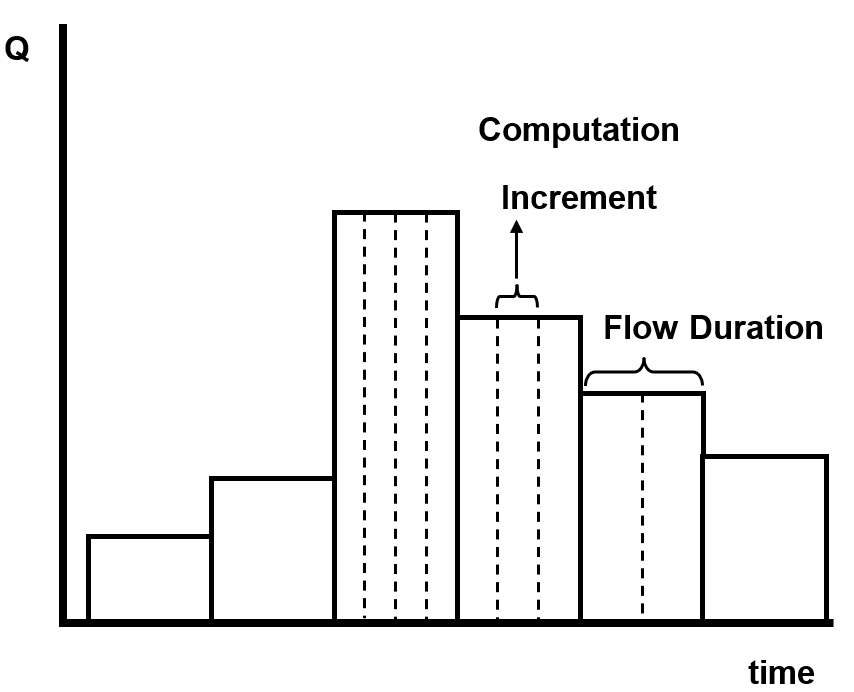The quasi-unsteady flow model simplifies hydrodynamics, representing a continuous hydrograph with a series of discrete steady flow profiles. HEC-RAS keeps flow constant for each flow record, computing transport over flow record duration. The steady flow profiles are more stable than the matrix solution of the unsteady Saint-Venant equations, but approximating a hydrograph with a series of steady flows does not conserve flow or explicitly account for volume.
The quasi-unsteady flow model has divides time into three time step. HEC-RAS divides each discrete steady flow profile (Flow Duration), over which HEC-RAS holds flow constant, into Computational Increments, which are the hydraulic and sediment transport time step. HEC-RAS updates the hydraulics and cross sections every Computational Increment, but further subdivides this time step into Bed Mixing Time Steps, updated bed gradation accounting for each bed layer several times each Computational Increment.
Duration
The Duration is the coarsest time step. HEC-RAS assumes that flow, stage, temperature, or sediment are constant over the Duration (below). For example, enter daily flow data (e.g. from a USGS day) with twenty-four hour Flow Durations.
Computational Increment
The Computational Increment is the primary quasi-unsteady hydraulic and sediment time step. The Computation Increment usually subdivides the Duration (below), though it can be equal (but not larger) to the duration. While flow remains constant over the entire flow duration, HEC-RAS updates the bed geometry and hydrodynamics after each computational increment. If cross sections change, particularly if they change rapidly, sediment sensitive hydraulic parameters can change even if the flow does not.
Model stability can be sensitive to the Computation Increment, because HEC-RAS assumes that hydraulics and bed geometry are constant. If the bed changes rapidly, large computation increments decouple the feedbacks between sediment and hydraulic processes, leading to unreasonable deposition or erosion, which can cause the model to crash. If HEC-RAS computes erratic bed change, experiment with Computation Increment sensitivity.
QtimeFlow Duration Computation Increment

Bed Mixing Time Step
Finally, HEC-RAS also subdivides Computational Increments into the bed mixing time step (sometimes called the SPI parameter). Bed gradation can evolve very quickly, so HEC-RAS updates the bed gradation accounting (running the bed sorting and armoring routines) several times during each computation increment.
HEC-RAS holds hydraulic parameters and cross section elevation constant over all mixing time step in a computation increment throughout the Computation Increment. However, the model updates the composition of the bed mixing layers (e.g. the active, cover and/or inactive layers) at the Mixing Time Step, revising the grain class accounting in these layers several times between hydraulic and sediment capacity computations. The vertical gradational profile changes response to the deposition or erosion even though the bed does not change until the end of the Computation Increment. Tighter accounting of bed gradation affects transport. HEC-RAS computes transport capacity base on the active layer gradation, so while the hydraulics (and transport potential, see below) remain constant throughout the Computation Increment, transport capacity can change between Bed Mixing Time Steps.